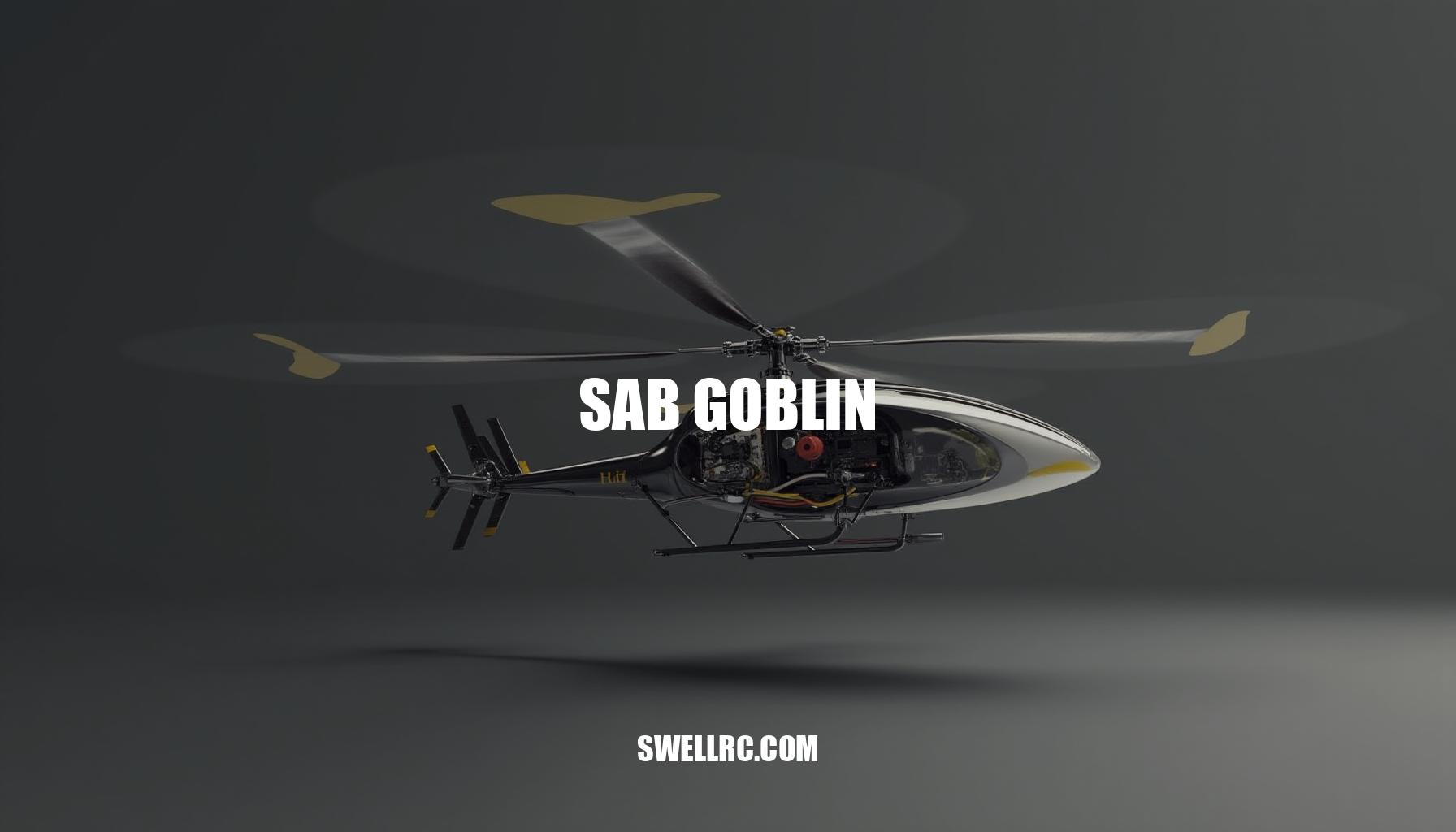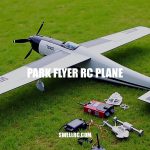SAB Goblin RC Helicopters: Precision Flight Redefined
The first time I saw a Goblin carve a hurricane low across the runway, the air actually sounded different—like the blades were drawing clean lines through the sky. It wasn’t just the speed; it was the composure. The bright high-performance canopy flashed, the tail held like it was on rails, and the pilot tipped into a waterfall of tic-tocs that felt impossibly precise.
That day hooked me. I’d flown plenty of RC helicopters before, but SAB Heli Division’s SAB Goblin series felt like a new class of purpose-built performance in the world of electric RC helis and 3D aerobatic helicopters.
SAB Heli Division, with its renowned Italian engineering roots, made a name designing high-performance blades and then reimagined the remote control aircraft helicopter around rigidity, visibility, and serviceability. The Goblin silhouette—sleek high-performance canopy, integrated boom, belt-driven tail, and battery tray that slides in like it belongs in a race machine—reset expectations for how a heli can look and fly.
These aren’t just fast; they’re efficient, tough, and deeply thought-out.
In this guide, I’ll walk you through the design philosophy, the flight feel, the lineup, and the practical setup tips that help a Goblin fly exactly the way you dream it should. If you’ve ever wondered whether a Goblin is worth the hype in the competitive world of RC helicopters and remote control aircraft, let’s dive in and find out.
The Philosophy Behind the SAB Goblin Design
SAB’s design ethos masterfully blends aerodynamic efficiency with structural integrity that pilots can truly feel in the sticks. The canopy is expertly sculpted to cut drag while ensuring unmissable visibility. Central to its robust design, the full-length boom houses the belt—known for being quiet and forgiving during light strikes—and doubles as a massive structural spine enhancing the helicopter’s overall strength.
The integration of carbon fiber helicopter frame side frames alongside CNC-machined aluminum bearing blocks ensures the main shaft stays perfectly aligned. This precise alignment minimizes vibration, allowing the flybarless controller to operate with superior precision. The outcome is tangible energy efficiency, evident in longer, stronger flights maintained at consistent head speed.
In comparison to many competitors, the Goblin series places a strong emphasis on service access. The battery tray snaps in seamlessly, servo geometry remains clean and linear, and the belt-driven tail system is engineered to reduce slop to a minimum. This level of precision cumulatively leads to more consistent governor behavior and crisper cyclic authority, hallmarks of precision engineering.
| Model | Design Focus | Key Features |
|---|---|---|
| SAB Goblin RAW | Minimalist, open-frame accessibility | Very light, direct feel; aerodynamic canopy with minimal extra plastic; outstanding maintenance access |
| SAB Goblin Kraken | Encapsulated, ultra-rigid transmission | Excellent crash energy distribution; helical gear train feel; exceptional tracking at extreme RPM |
| Goblin 500 Sport | Budget-friendly materials with core Goblin geometry | Robust and forgiving; ideal for stepping into the platform |
If you’re exploring different design philosophies across brands, Gaui frames offer a distinct weight distribution and canopy design philosophy, providing a different balance of stiffness and serviceability. Explore more about them here. For those intrigued by micro agility and innovative stabilization technology at a radically different scale, the Goosky S2 presents an alternative approach emphasizing lightness and advanced flight software—learn about it here.
Performance and Flight Experience
From the pilot seat, the SAB Goblin flight performance feels taut and extremely predictive. The spool-up process is clean, and once the governor locks in, even at high head speed, the airframe remains unnervingly smooth. With a well-tuned flybarless system tuning unit such as the VBar, Brain2, or Spirit, the RAW and Kraken models translate inputs into motion without lag — fast flips stop dead on a dime, piro maneuvers draw perfect cones, and big-air lines hold speed without bleeding altitude.
The disc loading is well balanced, offering the perfect mix of agility for 3D aerobatics and sufficient inertia for autos.
Tuning highlights I’ve found repeatable include:
- Dialing in collective management around your head speed (e.g., 1900–2050 RPM on a 700-class helicopter) and adjusting cyclic feed-forward to taste; keeping tail gain just below the wag threshold to preserve stop authority.
- Maintaining a moderate belt tension since too tight a belt wastes power and can overheat bearings, while too loose a setup invites bounce and tail drift.
- Using a strong governor and a brushless motor with ample headroom; brushless motor setup on Goblins rewards pilots with consistent torque and no sag under aggressive collective punches.
For perspective and across various performance bands, it’s helpful to compare the Goblin’s feel to other approachable models. The Exceed RC G2 helicopter serves as a stepping-stone collective pitch (CP) platform but doesn’t quite match Goblin torque retention or tail authority during fast reversals. The Esky 150 V3 functions as a compact trainer perfect for indoor muscle memory practice but is wind-limited outdoors.
For absolute beginners, the Hero RC H911 offers a docile fixed-pitch experience. Meanwhile, the XK K110S micro collective-pitch helicopter surprisingly mimics Goblin-style timing with resilience and power.
Key Goblin flight advantages noticed every session include:
- Rock-solid tracking from a rigid carbon and CNC-machined core, enhancing stability in flight.
- Crisp power delivery enabled by efficient brushless motor setups, improving responsiveness and energy usage.
- Predictable autos courtesy of a low-drag drivetrain combined with blade efficiency.
- A high-visibility canopy that bolsters confident orientation during dynamic maneuvers.
- A service-friendly layout encouraging meticulous tuning, key to optimizing flybarless system tuning and governor settings.
- An excellent parts ecosystem and upgrade path, making continuous performance enhancements accessible.
Model Lineup Overview: Comparing the Best SAB Goblin Versions
Choosing the right SAB Goblin model hinges on understanding your field size, preferred flying style, and budget constraints. Below is a model comparison that highlights key specifications like size and weight, flight time, difficulty level, and cost tiers to help you decide which Goblin is the best fit for your piloting needs.
| Model | Blade Size | Weight (AUW) | Flight Time | Difficulty Level | Cost Tier | Best Suited For |
|---|---|---|---|---|---|---|
| SAB Goblin RAW 700 | 690–715 mm | 4.2–4.8 kg (varies by packs) | Sport: 5–7 min; Hard: 3.5–5 min | Advanced | $$$ | Aggressive 3D and big-air precision with easy maintenance access |
| SAB Goblin Kraken 700 | 690–715 mm | 4.3–5.0 kg | 4.5–6.5 min | Pro | $$$$ | High-RPM aggressive smack flying; solid encapsulated drive |
| Goblin 500 Sport | ~500 mm | 2.2–2.7 kg | 4–6 min on 6S | Intermediate | $$ | Excellent first “serious” Goblin with strong performance |
| Goblin 570 | 550–570 mm | 2.8–3.5 kg | 4–6 min on 6S or 12S | Intermediate–Advanced | $$–$$$ | Sweet spot for medium fields |
| Goblin 700 (legacy/Competition) | 690–710 mm | 4.5–5.2 kg | 4–6 min | Advanced | $$–$$$ | Classic big-air workhorse still loved by many pilots |
If you’re earlier in your flight journey, starting with simpler or smaller helicopters before committing to a SAB Goblin is often wise. For true entry-level hovering and indoor orientation, the Syma S107 S107G stands out for its simplicity: Syma S107 S107G.
If you prefer scale looks, the Yuxiang F09 Black Hawk provides a unique, semi-scale flying experience: Yuxiang F09 Black Hawk. And for budget-friendly collective pitch practice in a 450-sized platform, the Gartt 450L is a popular choice: Gartt 450L.
Maintenance, Upgrades, and Customization
Treating your Goblin like a precision instrument ensures reliability and long-term value in your RC helicopter maintenance routine. Every few flights, it’s essential to check critical fasteners such as main shaft blocks, motor mounts, and tail cases for proper torque, reapplying thread locker if disassembled. Verify belt tension with a light, even twang along the boom, and inspect pulley teeth and idlers to maintain smooth operation.
Inspect the main and tail shafts for runout after hard landings, replacing dampers if the head starts to chatter—this is crucial for motor alignment and smooth flight dynamics. Balance and track blades meticulously, and log vibration levels using your FBL telemetry if available, which is a key part of blade balancing and flybarless tuning to minimize vibrations and enhance performance.
Setting the proper gear mesh at the motor pinion is vital; a thin strip of paper should slide out with a light crinkle, ensuring electronic setup efficiency and reducing component wear. Upgrades that significantly enhance your Goblin’s responsiveness include high-voltage cyclic servos offering strong torque and quick transit times, paired with a fast 760 µs tail servo for authoritative stops—these improvements optimize servo configuration for precise control. Select an ESC that is governor-capable, telemetry-friendly, and properly sized with headroom; many pilots favor 100–130 A units for 6S mid-sizes and 130–200 A for 12S 700-class machines.
Choosing a motor with the right kV matching your pack voltage and head speed target, while prioritizing torque and cooling, further elevates performance.
Flybarless controllers such as VBar, Brain2, Spirit, or AXON, when properly tuned for feed-forward and agility to your personal stick feel, provide refined electronic setup and flybarless tuning. Quality batteries—6S packs for 500/570-class and 12S or even 14S for 700-class setups—should maintain low internal resistance and be stored at proper charge levels to maximize long-term reliability.
Addressing common issues with quick fixes keeps your Goblin fleet flying tight and trouble-free:
- Tail wag at speed: Lower tail gain slightly, verify belt tension and tail blade tracking, and ensure tail servo frequency matches the FBL output for optimal servo configuration.
- Resonance and vibrations: Rebalance blades, check spindle and main shaft straightness—critical for motor alignment—and inspect head dampers and canopy grommets to maintain smooth RC helicopter maintenance.
- Governor hunting: Increase throttle deadband or adjust P/I gains; smooth pinion mesh and motor bearings help avoid erratic electronic setup.
- ESC overheating: Enhance airflow paths, verify timing, and check pitch curves to prevent overly aggressive RPM settings that strain components.
- Premature belt wear: Realign tail case and pulleys, avoid over-tensioning, and ensure the boom is square to the frames to prolong belt life and maintain reliability.
Through diligent maintenance, precise upgrades, and tuned flybarless systems, a well-cared-for Goblin will feel “new” for seasons, making long-term ownership both enjoyable and cost-effective.
Choosing the Right SAB Goblin for You
When considering your next gyroplane purchase, it’s crucial to evaluate factors like field size, current skill level, and your preferred flying style—be it aerobatics or big-air maneuvers—that truly make you grin. These decision factors directly influence your purchase decision and model selection.
Decision factors that matter:
- Field size: Small fields favor more compact models like the Goblin 500 or 570, whereas large fields are ideal for the Goblin 700 series.
- Flying style: If you thrive on big-air lines, larger discs such as the 570 and 700 excel. Conversely, fast 3D smack flying benefits from rigidity and power found in models like the RAW or Kraken 700.
- Skill and budget: For beginners stepping up from micros or fixed pitch, the Goblin 500 Sport offers an accessible entry point with manageable costs.
Advanced pilots improve with RAW or Kraken models, which reward tuning expertise and blade management.
Quick fit guide:
| Skill Level | Preferred Field Type | Recommended Model | Reason |
|---|---|---|---|
| Beginner | Small to Medium | Goblin 500 Sport | Ideal stepping stone post micro CP trainer; budget-friendly and beginner-oriented |
| Intermediate | Club Field / Medium | Goblin 570 | Offers headroom for growth; balances size for varied fields |
| Advanced | Accessible Fields | Goblin RAW 700 | Easy wrenching and optimized weight distribution |
| Competition / High-RPM | Large Fields | Goblin Kraken 700 | Provides locked-in monolithic rigidity suited for precise aerobatics |
| Legacy Fans | Large Fields | Goblin 700 (Legacy/Competition) | Classic big-air feel with modern electronics |
Ultimately, the journey from beginner to advanced pilot is a progression—consider starting with micros and 450s to hone your skills before transitioning to a Goblin. This strategic approach ensures your flying style and ambition align perfectly with the right model, budget, and field size, making your purchase decision rewarding and matched to your passion for aerobatics versus big-air flying.
Conclusion: The Future of Precision Flight
SAB Goblins have truly reshaped my expectations for what an RC helicopter should feel like—showcasing unparalleled precision flight that tracks with incredible accuracy, translating pilot intent into effortless, clean motion. The joy of flying a Goblin extends beyond the airtime; the hands-on experience of wrenching between flights deepens the connection between pilot and machine.
With relentless advancements in battery tech, flybarless (FBL) algorithms, and motor design, the Raw and Kraken lines stand out as innovative platforms, primed to absorb new gains and push the limits even further. This continuous evolution underscores the future of RC helicopters—a future that SAB Goblin innovation is helping to shape at the forefront.
If you’ve ever dreamed of an RC heli that not only flies spectacularly but also makes you better as a pilot by revealing your inputs with crystal-clear feedback, the Goblin is your honest partner in the sky.
Mastering one is not just a flight—it’s a journey of craft, tuning, and growing confidence, all of which pay dividends every time the skids lift and the main rotor bites the air. The electric RC performance delivered by these machines exemplifies the synergy of technology and pilot skill.
- SAB Goblin Innovation: Pioneering the latest in precision flight control and mechanical design.
- Flybarless Advancements: Enhancing responsiveness and reducing mechanical complexity for smoother handling.
- Personal Growth in RC Flying: Offering a platform that challenges and rewards pilots, accelerating their skills.
- Electric RC Performance: Leveraging cutting-edge batteries and motors for longer, more powerful flights.
- Future of RC Helicopters: Setting the standard for what’s to come in precision and pilot engagement.
The future of precision flight is undeniably bright, and with SAB Goblins, pilots are continually pushed to the leading edge of RC helicopter technology and personal development.
Frequently Asked Questions
- What makes the SAB Goblin helicopter different from other RC helicopters?
A Goblin combines aerodynamic, highly visible canopies with an ultra-rigid carbon/CNC core and a belt-in-boom tail, emphasizing precision, service access, and energy efficiency. That mix produces crisp tracking, strong autos, and a maintenance experience that encourages meticulous tuning. - Is the SAB Goblin suitable for beginners or only advanced pilots?
Total beginners should start with a micro or a basic CP trainer. The Goblin 500 Sport is the most approachable entry into the Goblin world, while the 570 and 700-class models suit intermediate to advanced pilots who already manage collective, orientation, and tuning. - Which SAB Goblin model is best for aerobatics?
For high-energy 3D and smack, the Goblin Kraken 700 is renowned for its locked-in, rigid feel at high RPM. The Goblin RAW 700 is an outstanding choice if you prize agility and easy access for rapid setup changes between flights. - How does the SAB Goblin compare to brands like Gaui or Goosky?
Goblins emphasize rigidity, belt-in-boom tail design, and service-friendly layouts for big-air and 3D precision. Gaui offers different frame geometries and weight distribution that some pilots prefer. Goosky’s S2 is a micro platform that showcases stabilization and lightness at a much smaller scale. - What materials are used in the SAB Goblin’s construction?
Goblin airframes use carbon fiber side frames, CNC-machined aluminum bearing blocks and mounts, composite canopies and booms for aerodynamic efficiency, steel shafts, and quality hardware designed for tight tolerances and durability. - How can I maintain or upgrade my SAB Goblin for better performance?
Keep belt tension moderate, verify gear mesh, balance blades, and track vibrations via your FBL. Upgrade to HV servos, a strong governor-capable ESC, a torque-rich brushless motor, and quality packs. Good tuning of the flybarless unit often yields the biggest performance gains.



